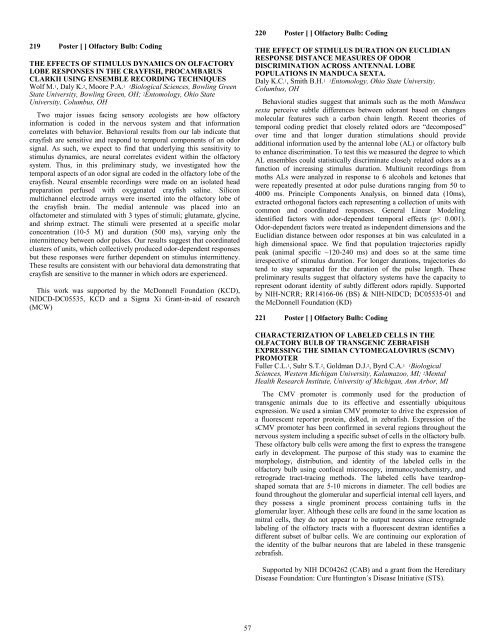Givaudan-Roure Lecture - Association for Chemoreception Sciences
Givaudan-Roure Lecture - Association for Chemoreception Sciences
Givaudan-Roure Lecture - Association for Chemoreception Sciences
You also want an ePaper? Increase the reach of your titles
YUMPU automatically turns print PDFs into web optimized ePapers that Google loves.
219 Poster [ ] Olfactory Bulb: Coding<br />
THE EFFECTS OF STIMULUS DYNAMICS ON OLFACTORY<br />
LOBE RESPONSES IN THE CRAYFISH, PROCAMBARUS<br />
CLARKII USING ENSEMBLE RECORDING TECHNIQUES<br />
Wolf M. 1, Daly K. 2, Moore P.A. 1 1Biological <strong>Sciences</strong>, Bowling Green<br />
State University, Bowling Green, OH; 2Entomology, Ohio State<br />
University, Columbus, OH<br />
Two major issues facing sensory ecologists are how olfactory<br />
in<strong>for</strong>mation is coded in the nervous system and that in<strong>for</strong>mation<br />
correlates with behavior. Behavioral results from our lab indicate that<br />
crayfish are sensitive and respond to temporal components of an odor<br />
signal. As such, we expect to find that underlying this sensitivity to<br />
stimulus dynamics, are neural correlates evident within the olfactory<br />
system. Thus, in this preliminary study, we investigated how the<br />
temporal aspects of an odor signal are coded in the olfactory lobe of the<br />
crayfish. Neural ensemble recordings were made on an isolated head<br />
preparation perfused with oxygenated crayfish saline. Silicon<br />
multichannel electrode arrays were inserted into the olfactory lobe of<br />
the crayfish brain. The medial antennule was placed into an<br />
olfactometer and stimulated with 3 types of stimuli; glutamate, glycine,<br />
and shrimp extract. The stimuli were presented at a specific molar<br />
concentration (10-5 M) and duration (500 ms), varying only the<br />
intermittency between odor pulses. Our results suggest that coordinated<br />
clusters of units, which collectively produced odor-dependent responses<br />
but these responses were further dependent on stimulus intermittency.<br />
These results are consistent with our behavioral data demonstrating that<br />
crayfish are sensitive to the manner in which odors are experienced.<br />
This work was supported by the McDonnell Foundation (KCD),<br />
NIDCD-DC05535, KCD and a Sigma Xi Grant-in-aid of research<br />
(MCW)<br />
57<br />
220 Poster [ ] Olfactory Bulb: Coding<br />
THE EFFECT OF STIMULUS DURATION ON EUCLIDIAN<br />
RESPONSE DISTANCE MEASURES OF ODOR<br />
DISCRIMINATION ACROSS ANTENNAL LOBE<br />
POPULATIONS IN MANDUCA SEXTA.<br />
Daly K.C. 1, Smith B.H. 1 1Entomology, Ohio State University,<br />
Columbus, OH<br />
Behavioral studies suggest that animals such as the moth Manduca<br />
sexta perceive subtle differences between odorant based on changes<br />
molecular features such a carbon chain length. Recent theories of<br />
temporal coding predict that closely related odors are “decomposed”<br />
over time and that longer duration stimulations should provide<br />
additional in<strong>for</strong>mation used by the antennal lobe (AL) or olfactory bulb<br />
to enhance discrimination. To test this we measured the degree to which<br />
AL ensembles could statistically discriminate closely related odors as a<br />
function of increasing stimulus duration. Multiunit recordings from<br />
moths ALs were analyzed in response to 6 alcohols and ketones that<br />
were repeatedly presented at odor pulse durations ranging from 50 to<br />
4000 ms. Principle Components Analysis, on binned data (10ms),<br />
extracted orthogonal factors each representing a collection of units with<br />
common and coordinated responses. General Linear Modeling<br />
identified factors with odor-dependent temporal effects (p< 0.001).<br />
Odor-dependent factors were treated as independent dimensions and the<br />
Euclidian distance between odor responses at bin was calculated in a<br />
high dimensional space. We find that population trajectories rapidly<br />
peak (animal specific ~120-240 ms) and does so at the same time<br />
irrespective of stimulus duration. For longer durations, trajectories do<br />
tend to stay separated <strong>for</strong> the duration of the pulse length. These<br />
preliminary results suggest that olfactory systems have the capacity to<br />
represent odorant identity of subtly different odors rapidly. Supported<br />
by NIH-NCRR; RR14166-06 (BS) & NIH-NIDCD; DC05535-01 and<br />
the McDonnell Foundation (KD)<br />
221 Poster [ ] Olfactory Bulb: Coding<br />
CHARACTERIZATION OF LABELED CELLS IN THE<br />
OLFACTORY BULB OF TRANSGENIC ZEBRAFISH<br />
EXPRESSING THE SIMIAN CYTOMEGALOVIRUS (SCMV)<br />
PROMOTER<br />
Fuller C.L. 1, Suhr S.T. 2, Goldman D.J. 2, Byrd C.A. 1 1Biological<br />
<strong>Sciences</strong>, Western Michigan University, Kalamazoo, MI; 2Mental<br />
Health Research Institute, University of Michigan, Ann Arbor, MI<br />
The CMV promoter is commonly used <strong>for</strong> the production of<br />
transgenic animals due to its effective and essentially ubiquitous<br />
expression. We used a simian CMV promoter to drive the expression of<br />
a fluorescent reporter protein, dsRed, in zebrafish. Expression of the<br />
sCMV promoter has been confirmed in several regions throughout the<br />
nervous system including a specific subset of cells in the olfactory bulb.<br />
These olfactory bulb cells were among the first to express the transgene<br />
early in development. The purpose of this study was to examine the<br />
morphology, distribution, and identity of the labeled cells in the<br />
olfactory bulb using confocal microscopy, immunocytochemistry, and<br />
retrograde tract-tracing methods. The labeled cells have teardropshaped<br />
somata that are 5-10 microns in diameter. The cell bodies are<br />
found throughout the glomerular and superficial internal cell layers, and<br />
they possess a single prominent process containing tufts in the<br />
glomerular layer. Although these cells are found in the same location as<br />
mitral cells, they do not appear to be output neurons since retrograde<br />
labeling of the olfactory tracts with a fluorescent dextran identifies a<br />
different subset of bulbar cells. We are continuing our exploration of<br />
the identity of the bulbar neurons that are labeled in these transgenic<br />
zebrafish.<br />
Supported by NIH DC04262 (CAB) and a grant from the Hereditary<br />
Disease Foundation: Cure Huntington´s Disease Initiative (STS).

















